the 2007 Abstract Presentations - Wound Healing Society
the 2007 Abstract Presentations - Wound Healing Society
the 2007 Abstract Presentations - Wound Healing Society
You also want an ePaper? Increase the reach of your titles
YUMPU automatically turns print PDFs into web optimized ePapers that Google loves.
<strong>Abstract</strong>s<br />
106<br />
IMPAIRED NOTCH SIGNALING SIGNIFICANTLY DELAYS<br />
WOUND HEALING<br />
Srinivasulu Chigurupati 1 , Tiruma V. Arumugam 2 , Shafaq Jameel 2 , Mohamed<br />
R. Mughal 2 , Mark P. Mattson 2 , Suresh Poosala 1<br />
1 Comparative Medicine Section, National Institute on Aging Intramural<br />
Research Program, 5600 Nathan Shock Drive, Baltimore, Maryland 21224,<br />
USA,<br />
2 Laboratory of Neurosciences, National Institute on Aging Intramural<br />
Research Program, 5600 Nathan Shock Drive, Baltimore, Maryland 21224,<br />
USA<br />
The evolutionarily conserved Notch-mediated intercellular signaling pathway<br />
is critically involved in cell fate decisions during development of many tissues<br />
and organs. Angiogenesis, <strong>the</strong> formation of new blood vessels, plays a central<br />
role in number of physiological and pathological conditions including wound<br />
healing which involves a switch in endo<strong>the</strong>lial cell phenotype from quiescence<br />
to proliferation, migration and network formation, and back to quiescence. In<br />
<strong>the</strong> present study we employed in vivo and cell culture models to elucidate <strong>the</strong><br />
role of Notch signaling in wound healing. Inhibition of Notch signaling in<br />
Notch antisense transgenic mice, and in normal mice treated with <strong>the</strong> g<br />
secretase inhibitor N-[N-(3,5Difluorophenylacetyl)-(S)-alanyl]-(S)-phenylglycine<br />
tert-butyl ester (DAPT), resulted in a significant delay in <strong>the</strong> healing of<br />
full-thickness dermal wounds. To fur<strong>the</strong>r examine <strong>the</strong> role of Notch signaling in<br />
cells involved in wound healing, we evaluated <strong>the</strong> effects of Notch inhibition on<br />
<strong>the</strong> behaviors of human umbilical vascular endo<strong>the</strong>lial cells (HUVEC) in a<br />
scratch wound healing test, a cell proliferation assay, cell migration assay and a<br />
tube formation assay in Matrigel. Treatment of HUVEC with DAPT inhibited<br />
scratch wound healing, cell proliferation and cell migration. Tube morphogenesis<br />
was also significantly disrupted by DAPT treatment. These results suggest<br />
that Notch signaling is involved in wound healing and tissue repair, <strong>the</strong>refore<br />
we conclude that targeting <strong>the</strong> Notch pathway might provide a novel strategy<br />
for wound repair and treatment.<br />
108<br />
IN SITU TISSUE ENGINEERING USING SELF-ASSEMBLING<br />
PEPTIDE IMPROVES WOUND HEALING AND<br />
NEOVASCULARIZATION IN A DIABETIC MOUSE MODEL<br />
S.S. Vaikunth 1 , S. Balaji 2 , A.R. Maldonado 1 , J. Parvadia 1 , F.Y. Lim 1 , T.M.<br />
Crombleholme 1 , D.A. Narmoneva 2<br />
1 Cincinnnati Childrens’ Hospital Medical Center,<br />
2 University of Cincinnati<br />
Self-assembling RADAII-16 peptide is a novel biomaterial which has been<br />
shown to create an angiogenic microenvironment and promote neovascularization<br />
in murine cardiac muscle. We asked whe<strong>the</strong>r this peptide would have a<br />
similar effect in an impaired diabetic wound healing model. We hypo<strong>the</strong>sized<br />
that peptide would increase neovascularization and improve wound healing in<br />
db/db mice. Db/db mice were confirmed to be diabetic with blood sugars<br />
greater than 300 gm/dL. Eight millimeter excisional wounds were made in <strong>the</strong><br />
flanks of mice. The wounds were <strong>the</strong>n treated with 50 ml PBS (n = 5) or peptide<br />
(n = 4). Mice were harvested at day 7 and wounds were analyzed by computerbased<br />
morphometric measurements of epi<strong>the</strong>lial gap, epi<strong>the</strong>lial height, and<br />
granulation tissue area. Vessel density was analyzed using lectin staining.<br />
Results are presented as mean standard error, and statistical analysis was<br />
performed using ANOVA. Peptide treatment resulted in larger granulation<br />
tissue area (2.77 0.6 mm 2 vs. 1.45 0.4 mm 2 ,po 0.05, peptide vs. PBS), larger<br />
epi<strong>the</strong>lial height (0.195 0.010 mm vs. 0.148 0.012 mm, p o 0.05, peptide vs.<br />
control), and enhanced vessel density (5.2 0.8 caps/HPF vs. 2.5 0.1 caps/<br />
HPF, p o 0.05, peptide vs. control). No significant difference in epi<strong>the</strong>lial gap<br />
was observed between <strong>the</strong> two treatment groups (4.8 0.4 mm vs. 4.4 0.4 mm,<br />
peptide vs. PBS). These results suggest that self-assembling peptide scaffold<br />
improves wound microenvironment and healing in diabetic animals and may<br />
offer a novel approach for in situ tissue engineering to augment wound healing.<br />
Acknowledgments: Funded by (TMC) 5RO1-DK072446, (TMC) 5RO1-<br />
DK074055.<br />
107<br />
IN VIVO EXPRESSION OF VEGF-R2 DURING EARLY<br />
SKELETAL ISCHEMIA-REPERFUSION INJURY<br />
M. Hofmann, R. Mittermayr, T. Morton, S. Pfeifer, M. van Griensven, H. Redl<br />
Ludwig Boltzmann Institute for Experimental and Clinical Traumatology –<br />
Research Center of <strong>the</strong> AUVA, Vienna, Austria<br />
Introduction: Different strategies were developed to reduce ischemia/reperfusion<br />
injury. One of <strong>the</strong> concepts includes <strong>the</strong>rapeutic angiogenesis with VEGF<br />
and its receptor as pivotal players. This study investigates <strong>the</strong> in vivo expression<br />
of VEGF-R2 during early murine hindlimb ischemia/reperfusion and its<br />
alteration via VEGF165 released from a fibrin biomatrix (FS).<br />
Material and Methods: Male/female transgenic FVB/N-Tg(Vegfr2luc)Xen<br />
mice (n = 12/group) were used for non-invasive, real-time assessment of <strong>the</strong><br />
VEGF-R2 (Flk-1/KDR) induction. Ischemia was induced by tension controlled<br />
(250 g) tourniquet to <strong>the</strong> hindlimb and verified by laser Doppler imaging<br />
(LDI, Moor Instruments Inc.) technique. Ischemia was maintained for 2 hours<br />
with subsequent reperfusion for 4 or 24 hours. Control animals received no<br />
treatment whereas <strong>the</strong> animals of <strong>the</strong> FS/VEGF groups received 0 or 20 ng<br />
VEGF/ final FS clot (0.2 ml in total) in <strong>the</strong>ir hindlimb subcutaneously, to<br />
distribute evenly around <strong>the</strong> muscle compartment, 15 min prior to reperfusion.<br />
The contralateral leg was used as an internal control. At different time points<br />
LDI was done to show hindlimb perfusion and bioluminescence detection was<br />
done to observe VEGF-R2 expression (VivoVision s IVIS s , Xenogen).<br />
Results: Applying <strong>the</strong> tourniquet resulted in ischemia as verified by a reduction<br />
of leg perfusion to approximately 10% in all groups. Ischemia was maintained<br />
for <strong>the</strong> entire 2 hours. Fur<strong>the</strong>rmore, restoration of blood flow was seen to 83%<br />
of baseline in <strong>the</strong> control group after 24 hours reperfusion. Similar reperfusion<br />
was observed in <strong>the</strong> vehicle and 20 ng FS/VEGF groups (112% and 95% of<br />
baseline). Edema was found in all groups in <strong>the</strong> injured hindlimb. The VEGF-<br />
R2 was slightly up-regulated in <strong>the</strong> control group after 24 hours of reperfusion<br />
in <strong>the</strong> ischemic, but not in <strong>the</strong> contralateral hindlimb. With VEGF in <strong>the</strong> fibrin<br />
biomatrix a significant increase in receptor expression was observed at 24 h,<br />
compared to baseline as well as to <strong>the</strong> control group while after 4 hours no<br />
receptor alterations were seen.<br />
Conclusion: This ischemia/reperfusion model in transgenic mice enables in vivo<br />
observation of <strong>the</strong> VEGF-R2 expression, a key receptor in angiogenesis.<br />
VEGF-R2 is only marginally up-regulated in <strong>the</strong> reperfusion period after severe<br />
ischemic conditions. However following <strong>the</strong> concept of <strong>the</strong>rapeutic angiogenesis,<br />
VEGF application from a fibrin biomatrix causes an increase in VEGF<br />
receptor expression at 24 h.<br />
109<br />
LASER CAPTURE MICRODISSECTION AND TISSUE<br />
ANALYSIS: EMERGENT TECHNOLOGIES IN WOUND<br />
RESEARCH<br />
Chandan K. Sen and Sashwati Roy<br />
The Ohio State University Comprehensive <strong>Wound</strong> Center, Columbus, OH<br />
43210<br />
Spatially-resolved cell-specific molecular analysis of tissue affected by focal<br />
injury is now possible because of current laser capture microdissection (LCM)<br />
technology. A variant of LCM is laser microdissection and pressure catapulting<br />
(LMPC). In LMPC, <strong>the</strong>biological material is placed directly on top of a<br />
<strong>the</strong>rmoplastic polyethylene napthalate membrane. The membrane acts as a<br />
scaffold to allow for catapulting relatively large amounts of intact material. A<br />
focused laser beam cuts out an area of <strong>the</strong> membrane and corresponding<br />
biological material. Next, <strong>the</strong> beam is defocused and <strong>the</strong> energy used to catapult<br />
<strong>the</strong> membrane and material from <strong>the</strong> slide. A motorized robotic stage moves <strong>the</strong><br />
sample through <strong>the</strong> laser beam path to allow <strong>the</strong> user to control <strong>the</strong> size and<br />
shape of <strong>the</strong> area to be cut. The catapulted sample is generally captured in an<br />
aqueous media (e.g. RNA or protein stabilizing solution). Under direct<br />
microscopic visualization, LMPC permits rapid procurement of histologically<br />
defined tissue samples from spatially-resolved (e.g. infarct vs peri-infarct;<br />
wound core vs leading edge) regions of <strong>the</strong> tissue. Recently, our laboratory has<br />
developed novel methods that enable <strong>the</strong> molecular study of specific regions of<br />
<strong>the</strong> infarcted heart with single cell resolution (Roy et al. Physiol. Genom 2006;<br />
Kuhn et al. AJP-Heart & Circ 2006 & <strong>2007</strong>). Even in frozen tissues, RNA<br />
degradation occurs rapidly. Thus, most standard immunohistochemical staining<br />
techniques are not suitable if <strong>the</strong> measurement of gene expression is desired.<br />
Rapid techniques for accurate histological identification are needed. We have<br />
developed an approach to identify and capture blood vessels from wound-edge<br />
tissue biopsies collected from patients with chronic wounds. Subsequent<br />
techniques to perform real-time PCR aswell as transcriptome analysis have<br />
been optimized. These developments and <strong>the</strong> potential of LCM/LMPC technology<br />
to illuminate new aspects ofwound biology from a novel vantage point<br />
will be presented. Supported by NIH GM069589 and HL073087.<br />
<strong>Wound</strong> Rep Reg (<strong>2007</strong>) 15 A14–A54 c <strong>2007</strong> by <strong>the</strong> <strong>Wound</strong> <strong>Healing</strong> <strong>Society</strong><br />
A43




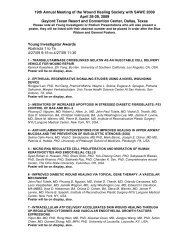

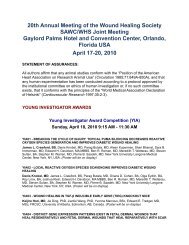
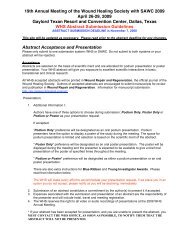
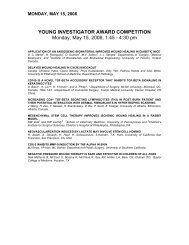



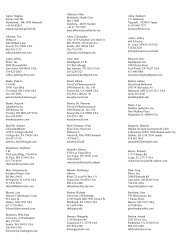
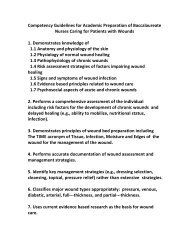
![2010 Abstracts-pah[2] - Wound Healing Society](https://img.yumpu.com/3748463/1/190x245/2010-abstracts-pah2-wound-healing-society.jpg?quality=85)